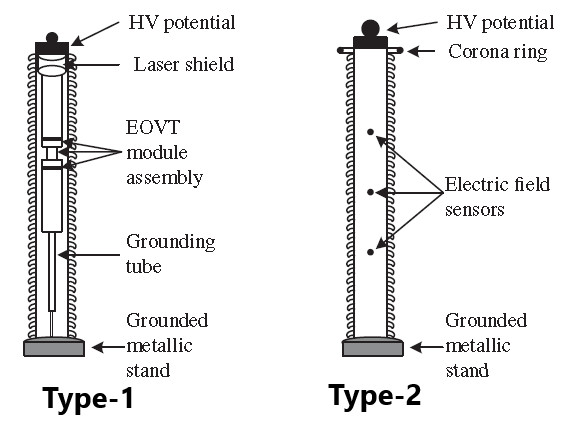In the foregoing, it has also been pointed out that CCVTs have difficulty retaining accuracy during transient conditions. In particular, the fundamental frequency filtering included in these devices prevents the accurate representation of step changes in voltage as may occur at the instant a short circuit happens. The filtering also prevents accurate measurement of harmonics and low frequency or dc components of a voltage waveform. Recently introduced optical voltage transducers (OVTs) provide better wide band performance and also provide most of the benefits previously mentioned for optical CTs.
In the case of OVTs, the voltage is usually measured by the Pockels effect (modulation of a light beam by an electric field). It is based on a characteristic of lithium niobate (LiNbO3) crystal. The crystal is called an electro-optic crystal. When exposed to an electric field, the index of refraction of one of its axes changes in proportion to the strength of the field, a characteristic called birefringence. The shift of axis can be analyzed by passing a beam of polarized light through the crystal, permitting accurate calculation of the voltage producing the field. The electric field is integrated over the length of the sensing crystal to produce the voltage.

Two types of OVT as shown in Figure.
Type 1 uses “line-to-ground continuous integration” in which the electric field strength is integrated over the length of a single electro-optic crystal.
Type 2 uses “line-to-ground distributed integration,” whereby multiple crystals are used, and their outputs are combined to determine the total line-to-ground voltage.
Similar to the case of OCTs, the OVT will include monitoring facilities that monitor the integrity of the measurement and raise an alarm if the measurement is found to be outside certain tolerances. Configuration and sensitivity of the monitoring facility settings will need to be carefully considered by the user in a similar fashion to the OCT.


Hello this is somewhat of off topic but I was wondering if blogs use WYSIWYG editors or if you have to manually code with HTML. I’m starting a blog soon but have no coding know-how so I wanted to get advice from someone with experience. Any help would be greatly appreciated!
I’m impressed, I have to say. Actually not often do I encounter a blog that’s both educative and entertaining, and let me tell you, you will have hit the nail on the head. Your thought is excellent; the problem is one thing that not enough persons are speaking intelligently about. I’m very glad that I stumbled throughout this in my search for one thing relating to this.
I’ve been browsing online more than three hours today, yet I never found any interesting article like yours. It is pretty worth enough for me. In my view, if all site owners and bloggers made good content as you did, the net will be a lot more useful than ever before.
Deference to op, some wonderful selective information.
Hello. splendid job. I did not anticipate this. This is a impressive story. Thanks!
Thanks for Appreciation, Please share my website to your social group
Well I sincerely enjoyed studying it. This article procured by you is very useful for accurate planning.
Hi there I am so happy I found your website, I really found you by error, while I was researching on Yahoo for something else, Regardless I am here now and would just like to say thanks for a marvelous post and a all round exciting blog (I also love the theme/design), I don’t have time to read through it all at the minute but I have bookmarked it and also added your RSS feeds, so when I have time I will be back to read a lot more, Please do keep up the awesome job.
Having read this I thought it was very informative. I appreciate you taking the time and effort to put this article together. I once again find myself spending way to much time both reading and commenting. But so what, it was still worth it!
I like what you guys are up also. Such intelligent work and reporting! Keep up the superb works guys I’ve incorporated you guys to my blogroll. I think it will improve the value of my website :).
Excellent weblog here! Also your web site quite a bit up very fast! What web host are you the use of? Can I get your associate hyperlink on your host? I wish my site loaded up as fast as yours lol
Simply wanna input on few general things, The website style is perfect, the written content is real superb. “We can only learn to love by loving.” by Iris Murdoch.
Wohh just what I was searching for, appreciate it for posting.
I simply desired to say thanks once again. I’m not certain the things that I could possibly have sorted out without those strategies contributed by you regarding this subject matter. It truly was a difficult issue in my circumstances, but observing the expert way you managed the issue took me to cry over fulfillment. Now i am grateful for your advice and then pray you know what a great job that you are carrying out educating men and women thru your web site. Most likely you’ve never met any of us.
Very efficiently written post. It will be helpful to anyone who usess it, as well as myself. Keep doing what you are doing – i will definitely read more posts.
Really clear site, thanks for this post.
I like this blog its a master peace ! Glad I observed this on google .
Some really excellent posts on this website , appreciate it for contribution.